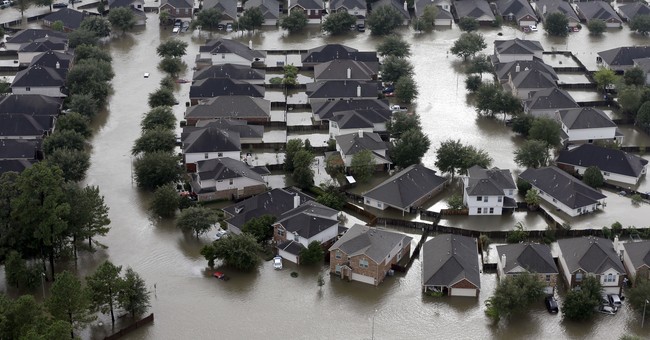https://townhall.com/columnists/pauldriessen/2017/09/09/draft-n2378956The Hurricane Harvey Hustleby Paul Driessen
Posted: Sep 09, 2017 12:01 AM
 Poster's note:
Poster's note:
This is an excerpt, for full article, see URL above (worth reading)"When a man knows he is to be hanged in a fortnight," English essayist Samuel Johnson observed 240 years ago, "it concentrates his mind wonderfully." That’s certainly true in the climate change arena.
After ending US participation in the Paris climate treaty and abolishing many government restrictions on fossil fuel use, the Trump Administration began preparing red team-blue team examinations of the science behind claims of “dangerous manmade climate change.” Asian, African, and even European countries are building still more coal and gas-fired power plants. A recent poll found that only 28% of Americans think climate scientists understand the causes of global climate change “very well.”
All this is certainly concentrating the minds of climate alarmists, who are also taking former Obama advisor Rahm Emanuel’s cynical advice to “never let a crisis go to waste.” The new climate hustle is on.
The record 12-year absence of Category 3-5 hurricanes striking the United States had to end at some point, and Hurricane Harvey definitely underscored our recent good fortune. Alarmists wasted no time in asserting that Harvey was due to or worsened by mankind’s greenhouse gas emissions. As Irma beefs up and brings more widespread devastation, it too will likely achieve iconic climate chaos status.
Fossil-fuel-driven global warming made the Gulf of Mexico warmer and its air more moisture-laden, thereby feeding Harvey’s strength and moisture content, said one climate and weather “expert.” A century ago a storm along the same path would have been less intense and brought less rain, claimed another.
Harvey stalled over Houston because manmade climate change caused “a greatly expanded subtropical high pressure system,” which led to “very weak prevailing winds” that failed to steer the storm back into the Gulf of Mexico, a third putative expert asserted. An Antifa climate activist ranted that Harvey was due to “this administration’s climate denial, racism, and callousness.” Another railed about climate murder.
Any journey back to climate and weather reality should begin by noting that doctrines of manmade climate cataclysm asserted that the record 12-year interlude between major US hurricanes should never have happened. The overall reduction in major hurricanes in recent decades shouldn’t have either.
Weather historian Roger Pielke, Jr. says 14 Category 4-5 hurricanes made landfall along US coasts, during the 44-year period between 1926 and 1969. In the ensuing 47 years, 1970 to 2017, just four struck the US mainland, including Harvey. Some, like the 1935 Labor Day Hurricane in the Florida Keys, were incredibly powerful. NOAA’s Hurricane Research Division counts 10 Category 4-5 monsters between 1920 and 1969 (50 years), but only four since then. Either way, it’s a huge reduction.
Harvey lost its Cat 4 status shortly after making landfall, so winds declined as a major factor after they destroyed Rockport. What devastated Houston was the vast quantity of rain: some 19 trillion gallons of water in the Houston/South Texas area alone. By comparison, Chesapeake Bay holds 18 trillion gallons.
Worse, all this rain came in just a few days. Harris County (Greater Houston) alone got 1 trillion gallons. The Mont Belvieu area got 51.9 inches of rain – the highest rainfall total in any storm in US history. The 16 inches of rain August 27 at George Bush Airport is the single wettest day in Houston history.
However, previous storms were not far behind. Hurricane Easy deluged Florida with 45.2 inches in 1950; Tropical Cyclone Amelia dumped 48 inches on Texas in 1978; Tropical Storm Claudette inundated Texas with 54 inches in 1979. In fact, Claudette emptied 43 inches in just 24 hours on the little town of Alvin, Texas; that one-day record still stands. Buffalo Bayou topped out at 62.7 feet this time – but it reached 54.4 feet in 1935. All the Texas storms were along its Gulf Coast.
All you need is the right (i.e., wrong) confluence of events. As climatologist Dr. Roy Spencer explains, when a strong tropical cyclone has access to abundant moisture evaporating from a large body of warm water like the Gulf of Mexico – and that situation combines with little inland movement by the cyclone – you get record rain. So why did Hurricane Harvey settle in for a long haul over Houston?
There was no “expanded subtropical high pressure zone,” WeatherBELL Analytics chief forecaster Joe Bastardi points out. What happened with Harvey was the “exact opposite.” What trapped Harvey was a predicted MJO phase 2 – a major cool trough associated with the eastward moving disturbance of clouds, rainfall, winds and pressure that traverses the planet every 30 to 60 days or so. “Normally,” there would be no major trough that far south to stop a storm, Bastardi notes. But this time there was.
So instead of moving inland (which it did later), Harvey stalled. Its circular winds remained stuck in the trough (or what Weather Channel founder John Coleman calls a “void”) until surface pressures around it changed, and the storm was able to move to the northeast. It was “an unusual pattern,” an unusual confluence of events, says Coleman, but it was “not unprecedented.” Amelia and Claudette demonstrated that. Name just one hurricane that was ever “steered back” into the Gulf of Mexico, Bastardi challenged.